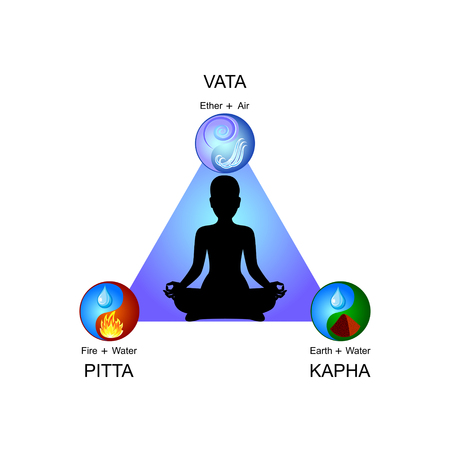
TRIDOSHA DISTRIBUTION
- March 30, 2021
- Posted by Dr. Vaidya Karanvir Singh
- 0 Comment(s)
Tridoshas are the three humors or forces of the human body, which preserve health when in balance, and develop diseases when out of balance. These three doshas are called Vata, Pitta, and Kapha.
The doshas assure that all mahabhutas are held together and exert their functions in collaboration for the optimum function of the human body. These are forces or energies that work together to maintain homeostasis.
- Vata is the energy that holds together Vayu and Akasha mahabhuta.
- Pitta is the force that holds together Jal and Agni mahabhuta.
- Kapha is the energy that holds together Jala and Pruthavi mahabhuta.
Table of Contents
Vata
Vata makes sure that your body movements take place without any hindrance. This includes absorption, nervous system conduction, cell ion exchange between extracellular and intracellular matter, all types of excretions, breathing, and musculoskeletal functions.
Pitta
Pitta has an equally important function in keeping together two very opposite qualities of fire and water. It’s like an acid, which is liquid in its existential state but burns. Pitta oversees this principle in the body. It brings about conversion, acts as the heat energy, digests food at gross and cellular levels. It transmits warmth, color, and vision to the body.
Kapha
Kapha is the cohesive and lubricating energy that holds together the conflicting elements of Jala and Prithvi. Suppose mixing stone and water. Kapha energy makes the body steady, the structures well held with muscle, ligaments, tendons, and fats. It also develops the protective coverings and fluid shock absorber for joints, brain (CSF), and spinal cord.
Doshas are further divided into 5 subtypes:
Vata:Prana, udana, Vyana, Samana and Apana.
Pitta:Sadhak, Ranjak, Bhrajak, Pachak and Alochak.
Kapha:Avalmabak, Tarpak, Kledak, Bodhak Shleshak.
Tridosha Distribution in Your Body
Broadly, Kapha is prominent in the chest, Pitta is dominant around the navel, and Vata below the navel. The organs like chest, heart, thymus (lymphatics), and stomach all are prominent in Kapha dosha. Small intestines, liver, pancreas, and all the intestinal digestive glands are leading in Pitta dosha. The bladder, rectum, uterus, caecum, and sphincters that open downward are all ruled by Vata Dosha.
Tridosha Distribution In A Day
Vata
- Vata is operating before sunrise, thus it is optimal to wake up at this time of the morning. In this way, the nervous system is active, the brain functions effectively, and is also the accurate time to evacuate bowels and urine.
- The nervous energy should be channelized for optimistic thoughts and hence, quite deep, and gentle breathing with meditation can do wonders at this time of the diurnal rhythm. This balances the whole system.
- The time before sunset (in the daytime) indicates plenty of energy to get the day’s work done and put the task to completion.
- The mind and body are active, innovative, productive, and excited. Communication and socialization are two activities that are finest done during this time.
Kapha
- Kapha is dominant in the morning and immediately after sunrise. Sleeping in the morning is not advisable, because sleep further develops Kapha and makes the system slow, sluggish, weight loss journey difficult and dulls the senses and mind.
- Since instantaneously after sunset is when most people adopt to eat, it is preferable to keep the meals light.
- Heavy meals generate more Kapha and result in lethargy. It is supposed that exercise in time majorly benefits the body.
- Making a strategy of the day in the morning and evaluating the day in the evening are best done in the Kapha periods. Kapha periods should be subjective.
Pitta
- Pitta is at peak in the noon. It’s the most preferable time to eat. Make lunch the biggest meal of the day.
- Pitta is also dominant around midnight and people who want to restraint overheating their body system should prevent keeping awake between 10.00 PM and 2.00 AM.
- One should not eat around midnight, though it is the Pitta period. This Pitta energy is essential for tissue level digestion. Accurately, the liver is most active at this time during the diurnal cycle.
- To not overload the system, food should never be consumed beyond 10.00 PM.
- Pitta time during the day is most preferable for eating, organizing, and taking definite action for tough tasks.
- At night, one should ideally be sleeping quietly for the body’s energy to clear up the toxins and metabolites at the tissue level.
Doshas at the different stages of life
Kapha is leading at a young age, from birth to adolescence, the body tissues are soft, flexible, and mind contemplative. Best time to learn, and prepare.
Pitta dominates from adolescence to the fifties. The bones now start to ossify (harden) and so does the mental state. One has passion and zest for life.
Vata is perceivably prominent in old age. The body is distressed with musculoskeletal derangement, weakening the perception of sense organs and fatigue.

Dr. Vaidya Karanvir Singh is the younger Vaidya in Chandigarh Ayurved & Panchakarma Centre. He is the fourth generation in his family who is practicing as a general consultant in Ayurved & Panchakarma treatment at Chandigarh. In his practice, he had treated more than 1 Lakh Plus patients worldwide.

